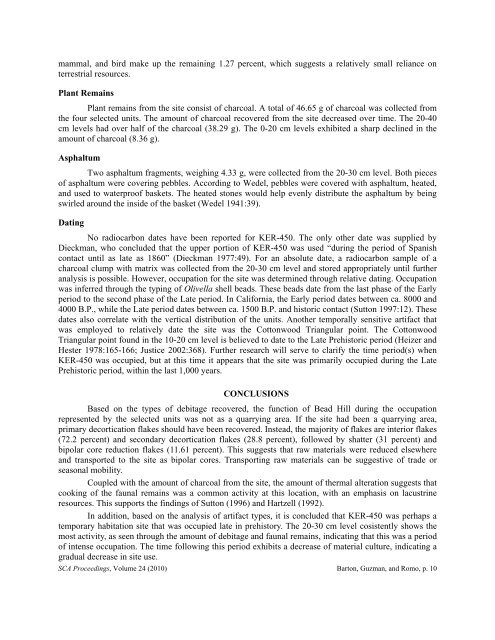at the bead hill site - Society for California Archaeology
at the bead hill site - Society for California Archaeology
at the bead hill site - Society for California Archaeology
You also want an ePaper? Increase the reach of your titles
YUMPU automatically turns print PDFs into web optimized ePapers that Google loves.
mammal, and bird make up <strong>the</strong> remaining 1.27 percent, which suggests a rel<strong>at</strong>ively small reliance on<br />
terrestrial resources.<br />
Plant Remains<br />
Plant remains from <strong>the</strong> <strong>site</strong> consist of charcoal. A total of 46.65 g of charcoal was collected from<br />
<strong>the</strong> four selected units. The amount of charcoal recovered from <strong>the</strong> <strong>site</strong> decreased over time. The 20-40<br />
cm levels had over half of <strong>the</strong> charcoal (38.29 g). The 0-20 cm levels exhibited a sharp declined in <strong>the</strong><br />
amount of charcoal (8.36 g).<br />
Asphaltum<br />
Two asphaltum fragments, weighing 4.33 g, were collected from <strong>the</strong> 20-30 cm level. Both pieces<br />
of asphaltum were covering pebbles. According to Wedel, pebbles were covered with asphaltum, he<strong>at</strong>ed,<br />
and used to w<strong>at</strong>erproof baskets. The he<strong>at</strong>ed stones would help evenly distribute <strong>the</strong> asphaltum by being<br />
swirled around <strong>the</strong> inside of <strong>the</strong> basket (Wedel 1941:39).<br />
D<strong>at</strong>ing<br />
No radiocarbon d<strong>at</strong>es have been reported <strong>for</strong> KER-450. The only o<strong>the</strong>r d<strong>at</strong>e was supplied by<br />
Dieckman, who concluded th<strong>at</strong> <strong>the</strong> upper portion of KER-450 was used “during <strong>the</strong> period of Spanish<br />
contact until as l<strong>at</strong>e as 1860” (Dieckman 1977:49). For an absolute d<strong>at</strong>e, a radiocarbon sample of a<br />
charcoal clump with m<strong>at</strong>rix was collected from <strong>the</strong> 20-30 cm level and stored appropri<strong>at</strong>ely until fur<strong>the</strong>r<br />
analysis is possible. However, occup<strong>at</strong>ion <strong>for</strong> <strong>the</strong> <strong>site</strong> was determined through rel<strong>at</strong>ive d<strong>at</strong>ing. Occup<strong>at</strong>ion<br />
was inferred through <strong>the</strong> typing of Olivella shell <strong>bead</strong>s. These <strong>bead</strong>s d<strong>at</strong>e from <strong>the</strong> last phase of <strong>the</strong> Early<br />
period to <strong>the</strong> second phase of <strong>the</strong> L<strong>at</strong>e period. In Cali<strong>for</strong>nia, <strong>the</strong> Early period d<strong>at</strong>es between ca. 8000 and<br />
4000 B.P., while <strong>the</strong> L<strong>at</strong>e period d<strong>at</strong>es between ca. 1500 B.P. and historic contact (Sutton 1997:12). These<br />
d<strong>at</strong>es also correl<strong>at</strong>e with <strong>the</strong> vertical distribution of <strong>the</strong> units. Ano<strong>the</strong>r temporally sensitive artifact th<strong>at</strong><br />
was employed to rel<strong>at</strong>ively d<strong>at</strong>e <strong>the</strong> <strong>site</strong> was <strong>the</strong> Cottonwood Triangular point. The Cottonwood<br />
Triangular point found in <strong>the</strong> 10-20 cm level is believed to d<strong>at</strong>e to <strong>the</strong> L<strong>at</strong>e Prehistoric period (Heizer and<br />
Hester 1978:165-166; Justice 2002:368). Fur<strong>the</strong>r research will serve to clarify <strong>the</strong> time period(s) when<br />
KER-450 was occupied, but <strong>at</strong> this time it appears th<strong>at</strong> <strong>the</strong> <strong>site</strong> was primarily occupied during <strong>the</strong> L<strong>at</strong>e<br />
Prehistoric period, within <strong>the</strong> last 1,000 years.<br />
CONCLUSIONS<br />
Based on <strong>the</strong> types of debitage recovered, <strong>the</strong> function of Bead Hill during <strong>the</strong> occup<strong>at</strong>ion<br />
represented by <strong>the</strong> selected units was not as a quarrying area. If <strong>the</strong> <strong>site</strong> had been a quarrying area,<br />
primary decortic<strong>at</strong>ion flakes should have been recovered. Instead, <strong>the</strong> majority of flakes are interior flakes<br />
(72.2 percent) and secondary decortic<strong>at</strong>ion flakes (28.8 percent), followed by sh<strong>at</strong>ter (31 percent) and<br />
bipolar core reduction flakes (11.61 percent). This suggests th<strong>at</strong> raw m<strong>at</strong>erials were reduced elsewhere<br />
and transported to <strong>the</strong> <strong>site</strong> as bipolar cores. Transporting raw m<strong>at</strong>erials can be suggestive of trade or<br />
seasonal mobility.<br />
Coupled with <strong>the</strong> amount of charcoal from <strong>the</strong> <strong>site</strong>, <strong>the</strong> amount of <strong>the</strong>rmal alter<strong>at</strong>ion suggests th<strong>at</strong><br />
cooking of <strong>the</strong> faunal remains was a common activity <strong>at</strong> this loc<strong>at</strong>ion, with an emphasis on lacustrine<br />
resources. This supports <strong>the</strong> findings of Sutton (1996) and Hartzell (1992).<br />
In addition, based on <strong>the</strong> analysis of artifact types, it is concluded th<strong>at</strong> KER-450 was perhaps a<br />
temporary habit<strong>at</strong>ion <strong>site</strong> th<strong>at</strong> was occupied l<strong>at</strong>e in prehistory. The 20-30 cm level cosistently shows <strong>the</strong><br />
most activity, as seen through <strong>the</strong> amount of debitage and faunal remains, indic<strong>at</strong>ing th<strong>at</strong> this was a period<br />
of intense occup<strong>at</strong>ion. The time following this period exhibits a decrease of m<strong>at</strong>erial culture, indic<strong>at</strong>ing a<br />
gradual decrease in <strong>site</strong> use.<br />
SCA Proceedings, Volume 24 (2010) Barton, Guzman, and Romo, p. 10
















